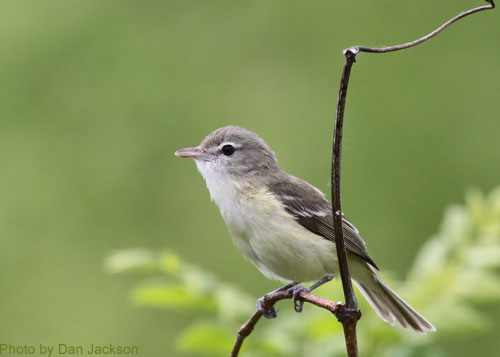
Vireo bellii
TAXONOMY
Vireo bellii Audubon, 1844.
OTHER COMMON NAMES
French: Virйo de Bell; German: Braunaugenvireo; Spanish:
Vireo de Bell.
PHYSICAL CHARACTERISTICS
4 in (11 cm). A relatively small and dull-colored vireo, with
olive-gray upperparts, white underneath, a broken (or incomplete)
white eye-ring, and faint whitish wing-bars.
DISTRIBUTION
Breeds in the southwestern and central United States and
south to parts of northern Mexico; winters from Baja California
to Honduras.
HABITAT
Shrubby vegetation, such as thickets of willows and mesquite,
especially in riparian habitat near streams and rivers.
BEHAVIOR
A migratory species that defends a breeding territory. The
song is a loud, high-pitched, melodious series of simple
phrases.
FEEDING ECOLOGY AND DIET
Feeds actively on invertebrates in foliage, flowers, and limb
surfaces. Also eats small berries when invertebrates are not
abundant.
REPRODUCTIVE BIOLOGY
Builds a small, cup-shaped nest that hangs from a fork in a tree
branch. Lays three or four eggs, incubated by both parents for
about 14 days.
CONSERVATION STATUS
Not threatened by IUCN criteria; relatively widespread and
abundant. Some populations are threatened by habitat loss
due to agriculture, mining, flood-control projects, and reservoir
construction. In 1986, the U.S. Fish and Wildlife Service
placed a subspecies, the least Bell’s vireo (Vireo bellii
pusillus), on the U.S. Endangered Species List. The Fish and
Wildlife Service regulates human activities in riparian habitat
used by the least Bell’s vireo in southern California and elsewhere
in its range.
SIGNIFICANCE TO HUMANS
None known.
Photo Gallery of - Bell’s vireo




 Animalia Life
Animalia Life